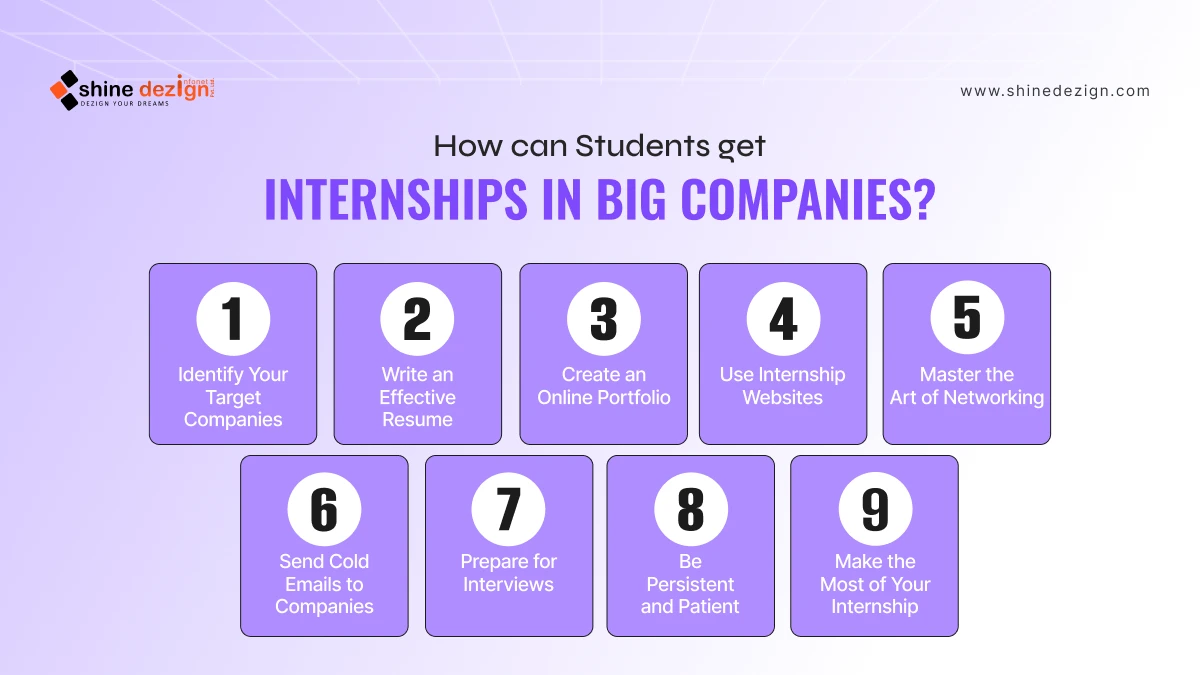Internships are a core component of student & recent graduates learning about important real-world training, networking & time to explore career opportunities.
Unfortunately, the application process for internships can be daunting. This article will provide an extensive step-by-step explanation of how to seek out companies for internships successfully, differentiating you from a sea of candidates.
What is the Importance of Internships?

Internships are an important aspect of beginning a career because they provide the following:
Real-World Experience:
Internships bridge the gap between theory and practical application. Internships allow you to apply theory to practice in real-life situations, and you learn how concepts learned in the classroom are applied in the workplace.
Networking Opportunities:
Internships provide a unique opportunity to network with industry professionals. Establishing relationships while interning can lead to mentorship, job offers & excellent references in the future.
Career Exploration:
Internships allow you to have a taste of different careers & industries, and they help you identify your likes & career goals. This realization can go a long way in helping you make wise decisions toward your future profession.
Increased Employability
Possibly, employers prefer students with internship backgrounds. Having done an internship can work wonders for your CV & you are an attractive choice for employment upon graduation.
How can Students get Internships in Big Companies?

Step 1: Identify Your Target Companies
Self-Reflection: Before you can start applying, it is good to consider your interests & career goals. You need to ask yourself:
- What industries am I interested in working in?
- What type of work do I see myself doing?
- And, what skills would I like to learn during internships?
Research Potential Companies: Once you have a clear vision of your interests, begin looking for companies with career goals matching yours. Here are some hints to allow you to search for potential employers.
Online Resources: Utilize websites like LinkedIn, Glassdoor & Indeed to search for companies based on your interests. Look for companies with a high number of internships for student and a strong reputation for their past interns.
Company Culture: Research company websites and social media pages to get to know their values, work culture, & work environment. This will help you decide if the company is right for you.
Make a Target List: Create a list of the companies you want to contact, their address and contact information & whatever useful information they have on their internship programs. This will sort your work as you begin making the contacts.
Step 2: Write an Effective Resume
Your resume most often creates the first impression that you make to prospective employers & therefore, you need to make it effective. Some of the most crucial elements that you need to add are:
Customized Content: Customize your resume for each application. Highlight relevant skills, experiences, and coursework in alignment with the internship role.
Achievements and Projects: Highlight academic accomplishments, pertinent projects, and volunteer activities if they demonstrate your abilities. Use quantifiable data to demonstrate the impact (e.g., “Increased social media engagement by 30% through targeted campaigns”).
Professional Layout: Adopt a tidy, professional layout that is easy to read. Employ a standard font & size and use consistent formatting throughout.
Other Tips
- Introduction Video: You may wish to create a short video of yourself introducing yourself & explaining why you are the best candidate for the internship. This can help you stand out from other candidates.
- Visual Appeal: Utilize design software like Canva to create visually attractive resumes & portfolios. Ensure your design reflects your personal brand & the industry you are seeking to enter.
Step 3: Create an Online Portfolio
Importance of an Online Portfolio: Having an online portfolio allows you to showcase your work and skills to prospective employers. It is a visual display of your capabilities & can set you apart from other candidates.
Creating Your Portfolio
Select Key Pieces: Choose some of your best pieces that most effectively represent your skills and experience. This could be class work, freelance work, or personal work.
User -Friendly Design: Keep your portfolio simple to navigate and easy on the eyes. Use descriptive labels, brief descriptions, and clear images or movies.
Regular Updates: Update your portfolio with your current work and achievements. This shows potential employers that you are currently working in your field.
Platforms to Use
Wix: A user-friendly website creator where you can create a professional portfolio.
WordPress: Something that you can utilize to create blogs & portfolios.
Behance: Excellent for creative professionals to showcase their work.
Step 4: Use Internship Websites
Advantages of Internship Platforms: Internship platforms could be extremely helpful in your internship hunt. They collate internship opportunities from various businesses, making it easier to look for chances based on your interest.
Recommended Sites
- Internshala: One of India’s most well-known sites connecting students with internships across a wide range of fields.
- InternMatch: A website that helps students find internships and entry-level jobs.
- WayUp: Focused on college students & recent graduates, WayUp offers a range of internship & job listings.
- Shine Dezign Internship Programs: Offer programs like DevOps training program, WordPress learning with the advantage of gaining hands-on learning experience while working on live projects.
Tips for Using Internship Websites
Set Up Notifications: All internship sites support setting up notifications on specific jobs or companies. This provides you with instant notification the instant new openings are placed.
Fill Up Your Profile: Ensure your profile is complete with your resume, skills & any projects available. Having a full profile gives you more opportunity to be viewed by employers.
Apply Early: A few employers fill internship spots on a rolling basis. Apply early & get a jumpstart over others.
Step 5: Master the Art of Networking
Building Professional Relationships: Networking is a critical aspect of landing internships. Creating professional connections in your field can bring opportunities that aren’t listed.
Leverage LinkedIn
Create a Strong Profile: Ensure your LinkedIn profile is complete & professional. Utilize a clear profile picture, create an interesting headline & include a summary that is all about your strengths & career aspirations.
Network with Industry Professionals: Send connection invitations to industry professionals. Personalize your invitations by referencing common areas of interest or common connections.
Engage with Content: Like, comment & share suitable content posted by your connections. This increases your profile and keeps you aware of industry trends.
Networking Strategies
Attend Events: Attend career fairs, workshops, and industry events to meet potential employers. Prepare a concise elevator pitch to introduce yourself and your interest.
Informational Interviews: Request short meetings with professionals to learn more about their careers & advice. Prepare thoughtful questions to make the most of these conversations.
Follow Up: Following informational interviews or networking sessions, write a thank-you note expressing your appreciation for their time and information. This helps reinforce the connection & keeps you in their mind.
Step 6: Send Cold Emails to Companies
Cold emailing could prove to be an effective way to reach out to firms that do not advertise internship openings. An effective cold email can highlight your initiative and passion.
Composing an Effective Cold Email
Personalization: Begin the email with a greeting using the recipient’s name and alluding to relevant information about their work or firm. This reveals that you’ve conducted research and are genuinely interested.
Clear Purpose: To be clear about your purpose. If you are requesting internship opportunities or guidance, be blunt and concise.
Professional Tone: To be formal yet friendly in the tone of the email. Use proper grammar & punctuation and not so casual language.
Include Your Resume: To send your resume with the email and mention it in the message body. This way, the recipient can quickly locate your qualifications.
Call to Action: End your email with a clear call to action, such as requesting a meeting or asking if they have an internship opportunity.

Step 7: Prepare for Interviews
Research and Practice: Once you receive an interview, preparation is the key. Here are some steps to prepare you.
Common Questions: Master common interview questions, such as “Tell me about yourself” & “What are your strengths and weaknesses?” Prepare answers that highlight your experience and skills.
Company Knowledge: Research the company’s mission, values & recent happenings. This will allow you to tailor your answers & demonstrate your genuine interest in the company.
Interview Etiquette
Dress Professionally: Choose professional attire that reflects the company’s culture. In doubt, wear business formal attire.
Punctuality: Show up on time for in-person interviews or log in early for online interviews. Punctuality shows respect for the interviewer’s time.
Body Language: Engage with good eye contact, offer a firm handshake (in person), and sit up in good posture. Positive body language conveys confidence & professionalism.
Follow-Up After the Interview: Following the interview, send a thank-you email to indicate you appreciate being interviewed. Reiterate how much you desire the job & put a brief remark on something during the interview that caught your attention. This is not merely being thankful but also highlighting your passion for the job.

Step 8: Be Persistent and Patient
Understanding the Process: The process of applying for an internship can be lengthy and competitive. It’s essential to remain patient and not lose hope on your search.
Keep Applying: Don’t get discouraged because you don’t hear back immediately. Keep applying to multiple positions so that you have a better opportunity of getting an internship.
Stay Organized: Keep tabs on the internships you apply for, application dates, follow-up dates, and feedback received. This will help you stay on top of your time and follow up in due course.
Seek Feedback: If rejected, attempt to call the company and request some feedback on your application or interviewing abilities. This will provide valuable insights for your future applications.
Step 9: Make the Most of Your Internship
When you get an internship, it is crucial to get the most from the experience. Below are some guidelines on how to do that so you acquire valuable skills & knowledge:
Set Clear Goals: Early in your internship, establish specific, concrete goals for what you want to achieve. Perhaps it will be to learn new skills, complete specific projects, or establish your professional network.
Be Proactive: Start to search for additional duties or projects. Show your ability to learn & assist & do not be afraid to request guidance or aid when needed.
Build Relationships: Use your internship to network with colleagues and management. Attend business functions, participate in team meetings & hold conversations to form genuine relationships.
Ask for feedback: Ask for feedback regularly from your supervisor & coworkers. Constructive criticism will assist you in improving & developing throughout your internship.
Document Your Experience: Maintain a journal or log of daily tasks, projects & achievements. This will not only assist you in contemplating your experience but also be a useful piece of content for your resume and subsequent interviews.
Conclusion
Obtaining an internship is a calculated process, from discovering target firms to composing compelling application documents & interviewing. Through compliance with the procedures in this guidebook, you can improve the chances of getting an internship aligned with your career goals.
Remember, internships are not simply experienced; they are relationship development, career exploration & building skills that you can apply later in life. Be aggressive, be determined, and try your best to make every opportunity you get work for you.
Your questions, our answers
You can find internship opportunities through various channels including job portals, networking, attending events, and college placement cells.
Yes, tailoring your resume for each application is crucial. Highlight relevant skills, experiences, and coursework that align with the specific internship role to increase your chances of being noticed.
Use your internship to network with colleagues and management. Attend business functions, participate in team meetings & hold conversations to form genuine relationships.
Your cover letter should include an introduction, a brief overview of your relevant skills and experiences, why you are interested in the company, and a closing statement expressing your enthusiasm for the opportunity.













